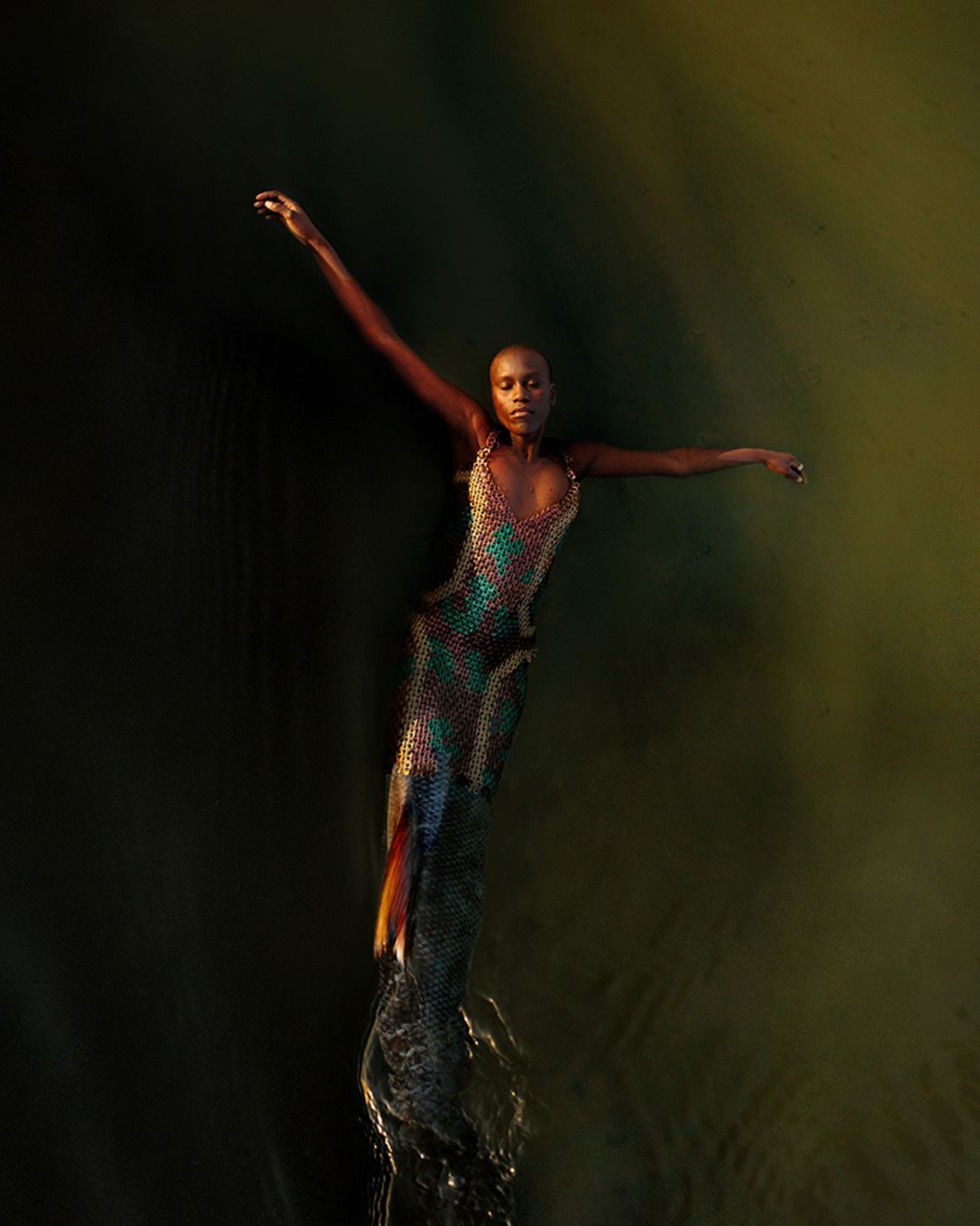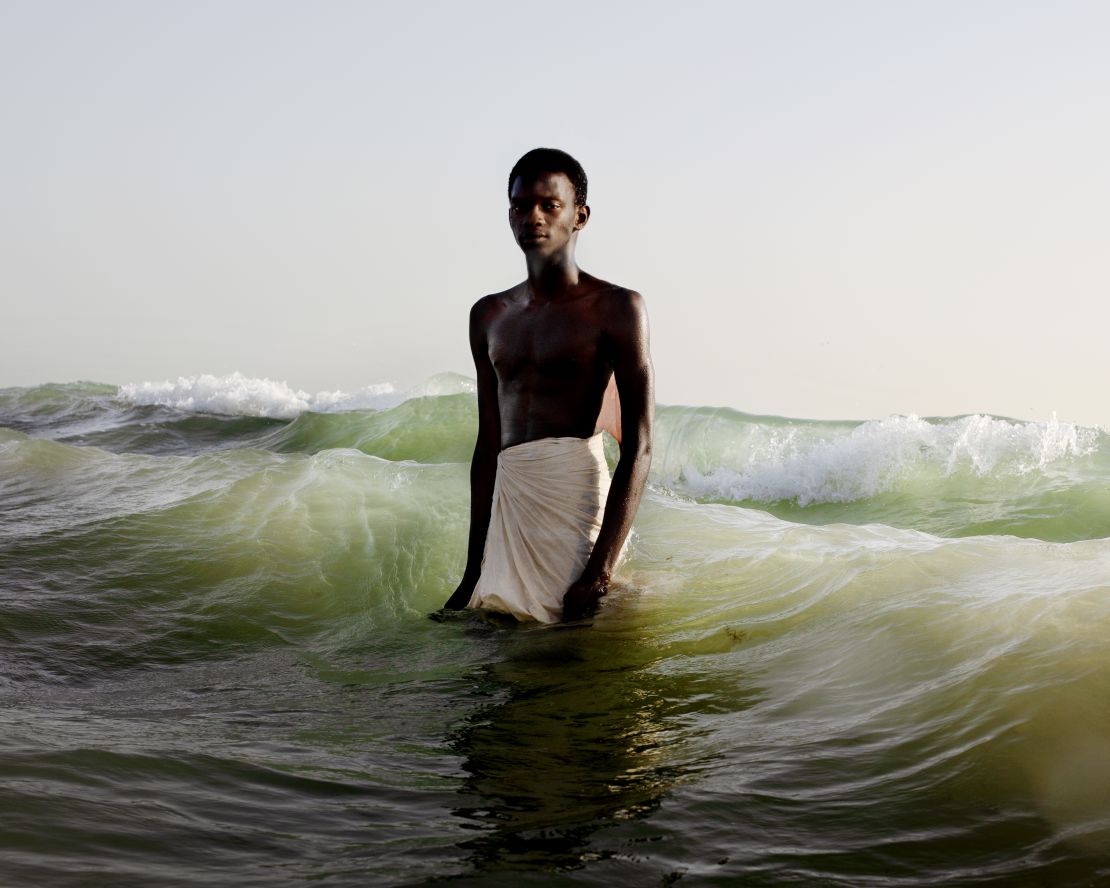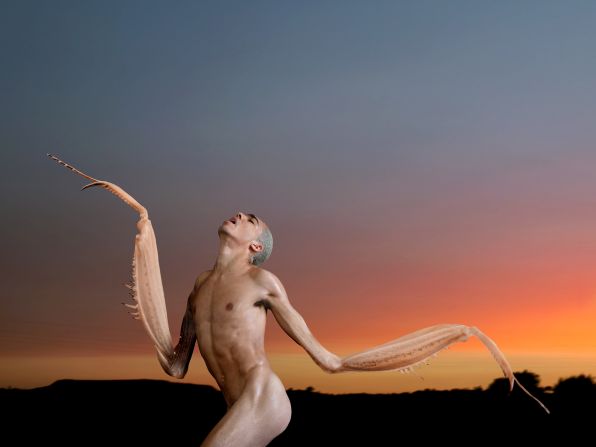When you think of mermaids, it’s hard not to picture the fish-tailed princess imagined by Hans Christian Andersen in his classic fairy tale: “her skin was as clear and delicate as a rose petal, and her eyes as blue as the deepest sea.”
After almost two centuries, global representation of mercreatures has only just begun to move past the image first conjured in “The Little Mermaid;” this year Disney is expected to release a live-action reimagining of the story with Black actress Halle Bailey in the leading role as Ariel.
But mermaids have always been an important part of African folklore. From the “Watermeids” of South Africa depicted in Khoisan rock paintings (some of which are believed to date back 28,000 years) to the water spirit “Mami Wata” recognized in oral tradition across the continent and the African diaspora in the Americas, Black mermaids long predate Ariel.
To help change the way we see the sea, Austrian Nigerian visual artist and photographer David Ụzọchukwu makes surreal fantasy portraiture that celebrates Black and Brown bodies.
The self-taught, 23-year-old’s work deals with longing and belonging, Black and queer identity, and magic.
His commercial photography includes collaborations with musicians FKA Twigs and Pharrell, fashion designer Iris Van Herpen, and the WWF, and he has received commissions from Dior and Hermès – but it’s his myth and fantasy images that capture the imagination.

‘Water and Blackness’
In November 2021, Ụzọchukwu showed at the Photo Vogue festival in Milan. For the festival he displayed images from an ongoing series which he began compiling in 2016 called “Mare Monstrum.”
The series is Ụzọchukwu’s first intentional body of work, moving away from single images, and is influenced by stories of fantasy creatures from the African continent and diaspora, and the fairy-tale and myth traditions of Europe.
“Within this mythological approach I find so much truth, and sometimes it’s such a satisfying take on political questions that are relevant to me,” said Ụzọchukwu. “I’m slowly figuring out how I can weaponize my art for a cause.”
Ụzọchukwu shot some of the images for the series on location in a coastal town in Senegal, a place from where, he says, people leave to make the journey to the Canary Islands and on to Europe – often never to be seen again.

“The series deals with the modern context of refugees. What I thought was interesting was these water metaphors used within the press: ‘waves of refugees.’ There was this idea of being ‘flooded’ by some sort of natural force,” he explained. As European citizens, he realized, “This human catastrophe is part of our responsibility and that sense of responsibility pushed me to pursue these themes.”
Through his work, he hopes to disassemble some of the violence experienced by refugees from the African continent as they make the dangerous crossing to seek shelter on European shores – and draw a parallel to the transatlantic slave trade.
“Historically there are interesting links between water and Blackness in the Middle Passage [the forced voyage across the Atlantic Ocean to become slaves in the Americas],” he added. “It’s really interesting to realize you’re part of a tradition.”
From self-portrait to surreal fantasy
Ụzọchukwu found his passion for image-making as a young teenager in Luxembourg. He initially took up the craft as a hobby to impress a love interest.
As he grew up, photography became a means of understanding and processing his own identity. “It was important in the beginning for me to be able to create this space where I felt seen, to create this stage for myself to perform various facets of myself,” said Ụzọchukwu.
He moved away from self-portraiture in the traditional sense, yet he maintains that every piece of his work could be considered self-portrait.
“Over time, I got more into post-production and that enabled me to start building worlds around myself, slip more into characters and create fantastical scenes and settings,” the artist said.
With a process that takes “weeks or months or even years,” Ụzọchukwu initially sketches out his concepts and images, then turns to his camera – allowing experimentation and development as he shoots. “That’s the first half of the process, getting that visual material,” he explained. “The second part is letting this all come together in the digital sphere, merging, a lot of times, a separate subject and background, and potentially dozens of images. It’s like digital collage – images layered and built upon each other.”

Through contorted poses and that delicate layering of images, Ụzọchukwu’s figures become bizarre sculptural forms in barren dreamscapes, somewhere between the surreal and hyper-real. He revels in the ambiguity of his work – his images simultaneously ethereal and ghastly, compelling and disconcerting.
“It’s like licking honey off a thorn, to have this bittersweet ambivalent approach to art, and I think particularly when it comes to Black bodies,” said Ụzọchukwu. “Having this ambivalence – to me, it feels very satisfying, and important to not engage in the binary discourse of either there is Black horror and absolute monstrosity, or there is Black joy, and no space for anguish.”
Moving image
Ụzọchukwu’s work is currently being displayed in a touring group exhibition, “Fire,” – hosted by international photography award group Prix Pictet – which just concluded at the V&A in London in January and opened earlier this month at Luma Westbau in Zurich, Switzerland.
The multimedia artist also released his first short film “GÖTTERDÄMMERUNG” last year, and is now finalizing his first film installation, called “Civil Dusk.” The multi-channel installation will tell the story of Igbo men building a home in their family village in Nigeria.
“It’s a tradition that my father followed and that became central within our family,” he said. “The film is a documentary-fiction hybrid, circling around understanding more about this really tangible link to home soil.”
Home is a theme central to much of Ụzọchukwu’s images. Finding belonging in art is important to him as a person of African heritage living in Europe, and therefore creating spaces of representation is crucial to him as an artist.
“It shouldn’t be a luxury to be able to see yourself in fantasy, and to imagine yourself in new contexts,” he said. “There is this deeply human need to dream, and there’s something so comforting about having visuals and having images and having something tangible that you can see yourself reflected in.”















